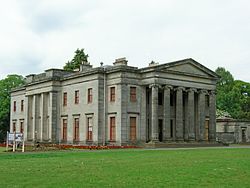Camperdown Wildlife Centre
| Camperdown House | |
|---|---|

Camperdown House, June 2006
|
|
| Coordinates | 56°29′02″N 3°02′46″W / 56.484°N 3.046°WCoordinates: 56°29′02″N 3°02′46″W / 56.484°N 3.046°W |
| Area | 400 acres (1.6 km2) |
|
Listed Building – Category A
|
|
| Designated | 12 July 1963 |
| Reference no. | 25078 |
| Designated | 1987 |
Camperdown Country Park, often known as just Camperdown Park, is a public park in the Camperdown area of Dundee, Scotland. The park comprises the former grounds of Camperdown House, a 19th-century mansion, which was bought by the city in 1946. Camperdown Park is home to a wildlife centre and recreational facilities. It is the largest park in Dundee, stretching to 400 acres (1.6 km2). Over 190 species of tree are found in the park.
Camperdown House is "the largest Greek Revival house remaining in Scotland." It is protected as a category A listed building, and the park is included on the Inventory of Gardens and Designed Landscapes in Scotland, the national listing of significant parks.
The Camperdown estate was originally known as Lundie, and was bought by Alexander Duncan in 1682. A 16th-century house stood on the estate at this time. Several members of the family served as Provost of Dundee during the 18th century. In 1797, during the French Revolutionary Wars, Admiral Adam Duncan (1731–1804) commanded the Royal Navy fleet that defeated the Dutch at the Battle of Camperdown. He was rewarded by being raised to the peerage as Viscount Duncan.
In 1820, his son Robert, 2nd Viscount Duncan, commissioned William Burn to design a new house in the Greek Revival style. The earlier house was demolished, and the new house was completed in 1828. Lord Duncan renamed the house and estate Camperdown in memory of his father's victory, and in 1831 he was created Earl of Camperdown by William IV. The parklands surrounding the house were laid out by Lord Camperdown, with the assistance of his forester David Taylor, who along with his son planted most of the estate's trees between 1805 and 1859.
...
Wikipedia

